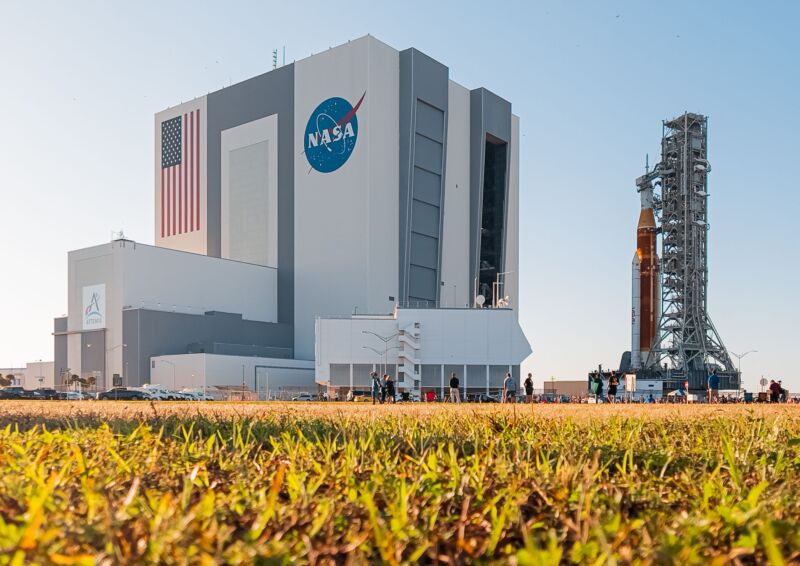NASA to roll back its mega rocket after failing to complete countdown test

Trevor Mahlmann
After three attempts to complete a critical fueling test of the Space Launch System rocket, NASA has decided to take a break.
On Saturday night the space agency announced plans to roll the large SLS rocket from the launch pad at Kennedy Space Center to the Vehicle Assembly Building in the coming days. This marks a notable step back for the program, which has tried since April 1 to complete a “wet dress rehearsal” test, during which the rocket is fueled and brought to within 10 seconds of launch.
The decision comes after three tries during the last two weeks. Each fueling attempt was scuttled by one or more technical issues with the rocket, its mobile launch tower, or ground systems that supply propellants and gases. During the most recent attempt, on Thursday April 14, NASA succeeded in loading 49 percent of the core-stage liquid oxygen fuel tank and 5 percent of the liquid hydrogen tank.
While this represents progress, it did not include the most dynamic portion of the test, during which the rocket is fully fueled and pressurized; and it, the ground systems, and computer systems are put into a terminal countdown when every variable is closely monitored. NASA had hoped to complete this wet dress rehearsal test to work out the kinks in the complicated launch system so that, when the rocket is rolled out later this year for its actual launch, the countdown will proceed fairly smoothly.
NASA said that its contractors, as well as its agency’s, will use the next several weeks to address problems that cropped up during the fueling tests when the SLS rocket returns to the large Vehicle Assembly Building. For example, gaseous nitrogen system supplier Air Liquide will upgrade its capabilities. NASA will also replace a faulty check valve on the upper stage of the rocket, as well as fix a leak on the mobile launch tower’s “tail service mast umbilical,” a 10-meter-tall structure that provides propellant and electricity lines to the rocket on the pad.
The space agency announcement did not provide any information about schedule impacts. It seems probable that it will take a week or so to prepare and roll the SLS rocket back to the Vehicle Assembly Building. Work on the rocket at that location will probably take up most of the month of May, at least.
NASA will then have to make some difficult decisions. It could opt to roll the rocket and its mobile launch tower to the pad a second time and try again to complete the wet dress rehearsal test. Then, following its normal procedure, NASA would roll the rocket back to its assembly building to arm the “flight safety system,” before rolling for a third time to the launch pad for liftoff. It seems the absolute earliest the SLS rocket could launch in such a scenario would be August, but a fall liftoff may be more likely.
Another option NASA could pursue is to roll-out, complete a wet-dress test on the pad, and then if that is successful, to go ahead and launch within a few days. Under such a scenario NASA might be able to launch the SLS rocket in June or July. However, this would be risky due to the flight safety system.
During a teleconference on Friday, Artemis Launch Director Charlie Blackwell-Thompson confirmed that there is a 20-day timeline once the flight safety system is armed. (This is a range safety mechanism used by all orbital rockets that destroys the booster in case it veers off course.) After the system is activated, it will take about a week to make final preparations in the Vehicle Assembly Building and a week to roll to the launch pad and make preparations there. That would leave just a single week for a fueling test, recycling of commodities, and perhaps one or two launch attempts before the 20-day window closes.
In other words, this means the wet dress test would have to be nearly flawless, and then the launch attempt would need to be flawless as well. It would also mean that summertime weather in Florida—when there are numerous thunderstorms and other inclement conditions—would have to cooperate.
Finally, NASA engineers must weigh a host of other factors, such as wear and tear on the rocket, its side-mounted boosters being exposed outside, as well as seemingly innumerable lifetime considerations with the hardware. For example, agency officials are closely tracking the health of the fuel in the solid-rocket boosters, which were stacked about 16 months ago, among other issues.
Still, NASA seems confident that it will get through this painful teething process for the SLS rocket: a program that is now…
Read More:NASA to roll back its mega rocket after failing to complete countdown test
